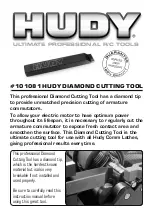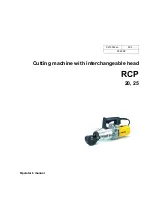
Operation
15
MAN0725 (10/3/2008)
Hydraulic Connection
1.
Inspect hydraulic hoses to ensure they are in good
condition.
2.
Clean the fittings before connecting them to the
tractor hydraulic ports.
3.
Route the hose through the hose holder at the
hitch and be sure the hose can slide freely in the
holder. Do not allow hose slack to drag on the
ground or become caught on tractor protrusions.
4.
Attach the hydraulic hose to the tractor.
5.
From the operator position, start tractor and raise
and lower deck several times to purge trapped air
from the hydraulic cylinder.
Interference Check
1.
Be sure that tractor 3-point lift links do not interfere
with hydraulic hoses, cutter driveline, or cutter
frame.
2.
Check for straight-ahead operation and at full
turning angles. If there is any interference, remove
the lower lift links.
3.
Contact between tractor lift links and cutter parts
can cause damage, especially when turning.
CV Driveline Turning Limits
NOTICE
■
You must not exceed a turning angle of 80
degrees at the head of the Constant Velocity drive-
line or damage will occur.
1.
To check for potential excessive turn angle,
disconnect the driveline from tractor.
2.
Start engine and turn as far right or left as possible.
3.
Shut engine off and try to connect CV driveline to
tractor. If it cannot be connected, the turn angle is
too severe.
4.
Restart engine and straighten angle slightly, shut
off engine and try to connect CV driveline to tractor.
5.
Repeat the process until the driveline can be
connected. The point at which the driveline can be
connected is the maximum turn that should be
made.
Cutting Height Adjustment
NOTICE
■
Avoid ground contact with blades. Striking
ground with blades produces one of the most dam-
aging shock loads a cutter can encounter. If this
occurs repeatedly, the cutter, driveline, and gear-
boxes will be damaged.
On pull-type or semi-mounted units with
optional hydraulic cutting height adjustment, use a
single-acting cylinder with a maximum extended
length of 28-1/4" (718 mm) from attaching point
center to center.
Cutting height range is from 2" to 15". A hydraulic cylin-
der or ratchet jack is available for cutting height adjust-
ment.
When selecting a cutting height, you should consider
the area of operation. If the ground is rolling and has
mounds the blades could contact, set the cutting height
accordingly. The cutting height (blade edge) is approxi-
mately 1" above the bottom of the side skid.
Cutting Height (Normal Mowing) - Center Section
1.
Position the cutter on a hard level surface and
select an approximate cutting height, Example 6".
2.
Raise wings and lock them in the UP position.
3.
Use the hydraulic cylinder or ratchet jack to raise or
lower the center section to obtain a distance of 5"
from bottom edge of skid shoe to the ground.
4.
Place jackstands under the four corners of the
center section. See chart on page 20. Lower center
section to relieve pressure on attitude rod nuts
5.
Loosen outer jam nut on the attitude rods.
6.
Adjust inner nuts in or out until the rear of the cutter
is approximately 1/2" higher than the front. See
Figure 1A. It’s used as a starting point for adjusting
the attitude rod, based on different tongue height
and wheel options.
7.
Raise cutter, remove jackstands and check deck
height. Tighten jam nuts against sleeve.
WARNING
(Rev. 1/9/2009)
Содержание Batwing BW240Q
Страница 1: ...OPERATOR S MANUAL BATWING MAN0725 Rev 9 11 2013 BW240 BW240Q...
Страница 46: ...46 Parts MAN0725 10 3 2008 MAIN FRAME ASSEMBLY FRONT SECTION Rev 9 11 2013...
Страница 48: ...48 Parts MAN0725 10 3 2008 MAIN FRAME ASSEMBLY REAR SECTION...
Страница 50: ...50 Parts MAN0725 10 3 2008 WING ASSEMBLY Rev 9 21 2009 Right Wing Shown...
Страница 52: ...52 Parts MAN0725 10 3 2008 WING CENTER GEARBOX ASSEMBLY...
















































